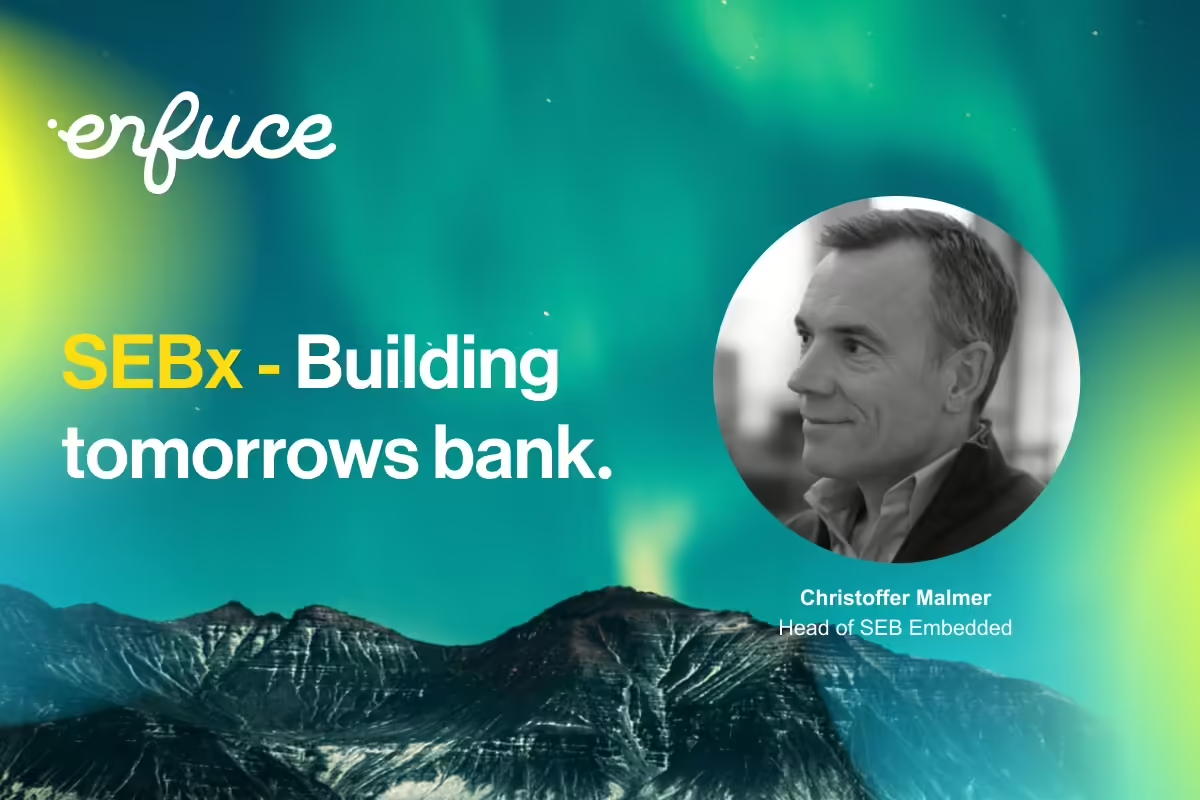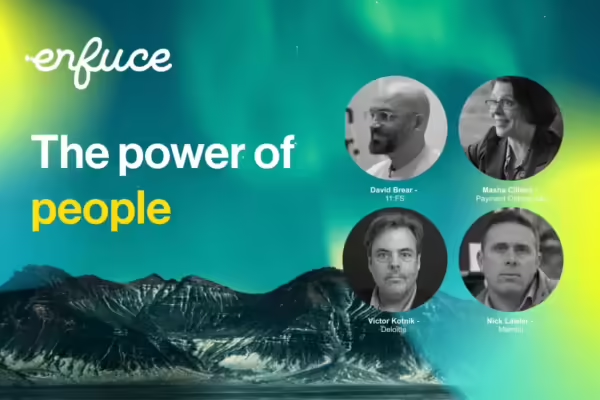Building tomorrow’s bank

2024 is a dynamic and exciting space for modern finance with fintechs offering a multitude of innovative solutions and traditional organisations jostling to collaborate with them.
Within these transformative partnerships, some financial services institutions are discovering completely new business models and revenue opportunities – which is exactly what happened when SEB Embedded embarked on their card program journey.
Download The builder’s guide to strangely satisfying card experiences, created for you by industry experts.
A participant in our Builder’s Guide to Strangely Satisfying Card Experiences, Christoffer Malmer sat down with us to chat about his experience in pivoting from traditional financial service to blazing a trail in Banking-as –a-Service (BaaS) via the build of a modular card program.
Out of the starting blocks
“SEB Embedded is an initiative that sprang out of something called SEBx, which was an exploration initiative that we started as an innovation studio more than five years ago with the intention of exploring new businesses and tech. We felt that in an era where technological developments are accelerating and customer experiences and expectations are shifting dramatically, that the ability to bring new products and services to our customers has never been more important.”
Established in 1856, SEBx boasts a rich legacy, but the organisation is also committed to future-proofing. By carefully assessing the strengths and competitive advantages and drawing from their deep institutional knowledge, Malmer and team identified key capabilities and functionalities where the business excelled, particularly in navigating the intricacies of banking platform infrastructure.
“Our expertise lies in managing complex financial relationships, navigating digital agreements, and offering financial services across diverse contexts. Over the years, we’ve encountered challenges in these areas, leading us to recognize the importance of maintaining a modular, scalable, and flexible architecture and we felt these are the kinds of things we could build and own.”
But Malmer was also realistic when it came to the basic infrastructural pieces that were needed and how to differentiate SEB Embedded from the competition.
“We didn’t think it made sense to build our own cloud infrastructure. We decided on GCP, leveraging all the knowledge and all the expertise that Google pours into cloud infrastructure and security every year. When we realised we needed a card processor, the same thinking applied – we needed a business born cloud-natively, that works effectively and with an innovative approach to technological infrastructure around cards and card processing. But building our own wouldn’t differentiate us. What would differentiate us is being a regulated financial institution with strong tech partners and very easy to use APIs for accessing banking as a service (BaaS). That’s what would make us stand out.”
Unlocking the opportunity
SEB Embedded believed that by orchestrating a combination of services, products, and providers, they could bring something unique to the marketplace.
SEB Embedded decided to do things differently.
“We wanted to build SEB Embedded as an organisation with lot of new talent, new ways of working, modern infrastructure and the support of SEB the limited company – with the banking license, the balance sheet in capital liquidity and funding data, customers, licenses, and all those things. The opportunity was to combine those two worlds into one organization.”
Malmer believes the pros outweigh the cons in establishing this hybrid business.
Download The builder’s guide to strangely satisfying card experiences, created for you by industry experts.
“The nature of SEB Embedded would mean that sometimes we were going to be a bit slower than the fintechs because we are part of the regulated bank, and we need to do more checks and controls and balances along the way. But sometimes we’re going to be faster than the fintech because we don’t have to apply for licenses, we don’t have to build a balance sheet etc. We are really trying to leverage the strength of those two aspects.”
As they crafted this value proposition and user journey, a core element of the new model that emerged was a versatile card program that would seamlessly integrate private and business transactions, giving users the flexibility to allocate purchases to their respective accounts, along with other user-friendly and innovative functionalities. It was then that the SEB Embedded team realised their trajectory was leading them towards offering BaaS to external customers and they needed a partner to help them realise this potential.
“We needed delivery when it came to card processing, which was tailored to onboarding multiple different distributors, configuring products in multiple different ways, issuing them in different configurations in different settings, and quite quickly being able to adapt and develop new products. We needed a card processor that was a new breed from a technology perspective. One that was born cloud native and has been from the very beginning, a little bit like SEBx.”
Malmer says there were a host of different elements to consider when looking for this forward-thinking partner to help them pivot business models.
“There were technological hygiene factors we were looking for, like who can help us deliver banking as a service? It means the ability to operate in this kind of cloud type environment. It means swift response to change requests. It means a high degree of configurability. It means modern API, microservices-based infrastructure. That narrowed the search a little bit. But then it came down to relationship and focus. How important would we become to that partner? Stability was key; some of these card processing challengers are very young, very modern. We wanted to work with a partner that also had a good and prosperous business to grow themselves, but one with a can-do mentality. We found that in Enfuce.”
Christoffer Malmer – Head of SEB Embedded
What happened next
The big question for SEB Embedded after building infrastructure from scratch, setting up cloud natively with technology partners and launching the customer value proposition was, how do they scale this?
At that point, the organisation had one distribution channel – the one they had built themselves for small business customers. But now the desire was to leverage and scale the infrastructure to add as much volume as possible to reap the benefits of scale. And that’s where the thought of lending the platform more broadly into the marketplace occurred.
The first route explored was offering the rest of the bank the new infrastructure that supported traditional banking products in a different tech set-up.
“We invited the bank to use the APIs and build products and services on top of them, brand them and take them to market under the SEB branding.”
The next step was to open the offer up to external distributers like retailers, media companies, entertainment companies and digital platforms of different forms that wanted to embed financial services into their digital user journeys. Having built the infrastructure that really lends itself to distributing banking as a service via APIs, SEB Embedded are now happily distributing those via channels that they built ourselves, via the rest of the bank and via third party distributor BaaS into the marketplace.
“Now we’re looking for partners to step in and help us drive this business forward, partners that are more mature. So yes, we are a buyer, and yes, they are sellers of the particular service or product that we’re procuring, but it is a true partnership, and we are helping each other out. We recommend our partners to other interested businesses and in some cases, we are even investing in some of the technology partners that we work with.”
Reflecting
While Malmer celebrates the organisation’s progress in innovation, partnerships, and investments, he remains keenly aware of the bottom line. In the start-up world, he believes success is binary—either you thrive or you don’t.
“Ultimately, SEB Embedded’s vision is to create shared value and shared value is measured by the economic profit that we generate. That’s a function of the customers that we onboard, the products we sell and business that we manage to build. There’s no other yardstick at the end of the day. And I’m conscious that even though we’re a small piece of a very large financial institution, we hold ourselves to those same standards.”
Looking back on the journey so far, one of the achievements Malmer is most proud of is the team they’ve put together.
“As we forge ahead in the realm of banking as a service, I’m filled with confidence in our team’s agility and adaptability. Whether it’s a market tweak or a significant change, I’m certain they’ll rise to the occasion, ready to adjust as needed.”
Their path hasn’t been all smooth sailing either. Malmer also believes in the power of failing forward and that every setback is an opportunity to iterate, pivot, and ultimately, emerge stronger.
“Our journey is defined not only by our successes but also by our resilience in the face of challenges. Even when we stumble, we recognize the immense value in the lessons learned, experiences gained, and relationships forged.”
Looking forward, it’s clear that the key to success in this new world of banking is in flexibility and adaptation. As customer expectations soar, the demand for innovative solutions is non-negotiable, while the trust customers place in experienced banks is still relevant. This juxtaposition creates the perfect opportunity for modular partnerships, where fintechs and banks unite to shape the future of finance.
Download The builder’s guide to strangely satisfying card experiences, created for you by industry experts.



